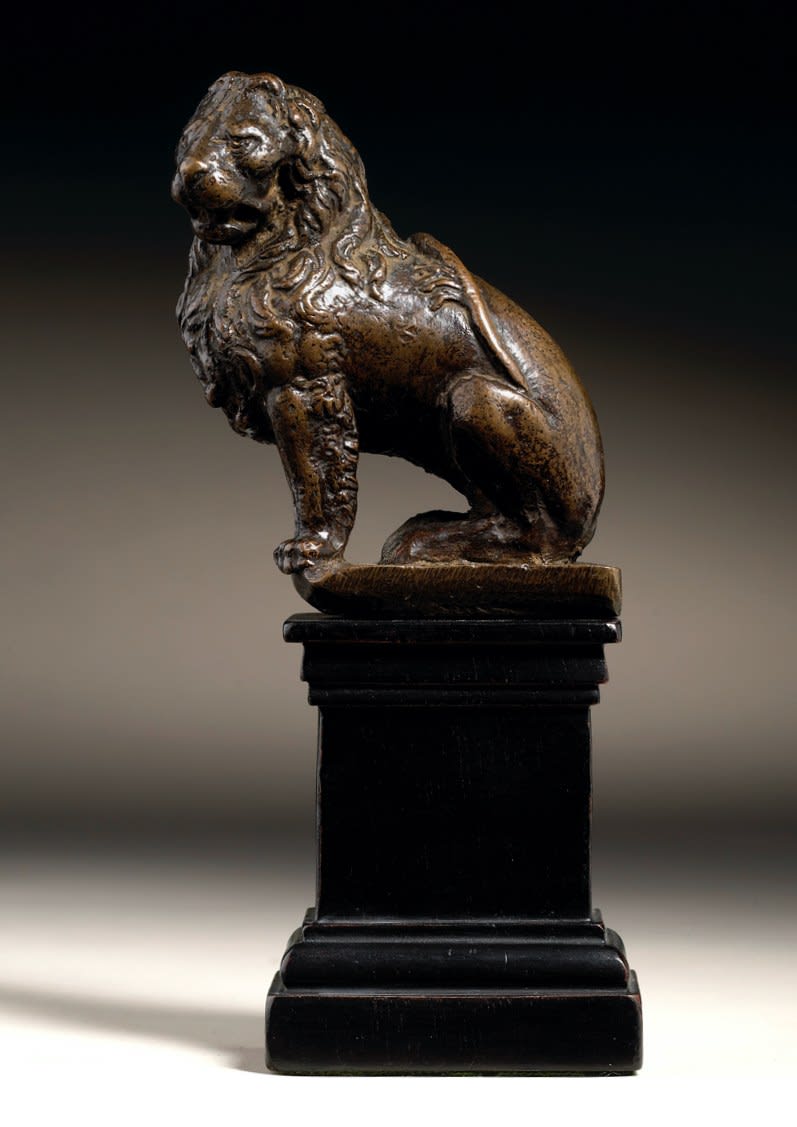Seated Lion, Probably After the Marzocco of Florence, Florentine, circa 1500
8.6 x 7 x 3.5 cm
This small but impressive statuette appears to be unpublished. In pose and demeanour (apart from the turn of its head in the opposite direction) it resembles the civic lion of Florence – a stone, sometimes gilded, or marble statue that has long stood like a symbolic sentry at the corner of the dais (ringhiera) in the Piazza della Signoria. This is sometimes known as the ‘Marzocco’, because it resembles the winged lion that is the symbol of St Mark.
Presumably because the last of a long line of statues of the civic lion had, like its predecessors, weathered away, the Marzocco was replaced after 1812 with a similar lion carved in grey sandstone (pietra serena) by the great Donatello. This had been made in 1418 to ornament the newel-post of the stairs to the papal apartment in the monastery of Santa Maria Novella, which were demolished a century later. It supports with a forepaw a shield bearing the civic arms, a fleur-de-lys or iris (il giglio). In 1885 Donatello’s original was removed to the Museo del Bargello for the sake of conservation and replaced with the present cast in bronze.
The Marzocco’s appearance seems to vary over the years in paintings, not just with the styles of successive periods or artists, but also probably because the stone beast had periodically to be replaced and its own style changed in the process. The earliest depiction is in an anonymous painting of the martyrdom of Savonarola in 1497 (Museo di San Marco, Florence), closely followed by a fresco showing The Confirmation of the Rule by Domenico Ghirlandaio in Santa Trinita (Brucker 1983, p. 135, pl. XX). There are other appearances, in the background of Piero di Cosimo’s portrait of an anonymous soldier – presumably a member of the national guard – in the National Gallery, London (inv. no. 895; datable after 1504, given that Michelangelo’s David is also shown in situ); in Giovanni Stradano’s fresco of The Return of the Medici in 1513 on the walls of the Palazzo della Signoria (Del Meglio et al. 2005, pl. 35); a later fresco showing a firework display, at a date when Bandinelli’s Hercules and Cacus and Cellini’s Perseus had joined the collection of monumental statuary in the Piazza; and Vasari’s Festa degli Omaggi (Feast of the Homages) fresco in the Sala di Gualdrada of the Apartments of Eleonora in the Palazzo Vecchio (c. 1555–65; Allegri and Cecchi 1980, p. 211, figs. 13, 48).
Its origins as a civic symbol are unknown. One theory holds that it was chosen as the symbol of the Guelph party, to contrast with the eagle of their deadly rivals, the Ghibellines. In any case by 1363 its status was firmly established and captives from Pisa were made to kiss its posterior.
The present statuette, seated four-square on a slightly projecting plinth, undercut at the front, distinctly resembles stone lions from newel-posts attributed to the workshop of Michelozzo di Bartolommeo, Donatello’s associate, in the monasteries of Santissima Annunziata and Sant’Apollonia (Del Meglio et al. 2005, pls. 44–45). Yet the much more fluid hair of the mane and fuller modelling of the muzzle suggest a date towards the end of the fifteenth century and the influence of Verrocchio or Bertoldo.
Dr. Charles Avery
Related Literature:
E. Allegri and A. Cecchi, Palazzo Vecchio e i Medici – Guida storica, Florence 1980
G.A. Brucker, Firenze 1138‒1737: L’impero del fiorino, Florence 1983
A. Del Meglio, M. Carchio and R. Manescalchi, Il Marzocco – The Lion of Florence, Florence 2005Join our mailing list
* denotes required fields
We will process the personal data you have supplied to communicate with you in accordance with our Privacy Policy. You can unsubscribe or change your preferences at any time by clicking the link in our emails.

